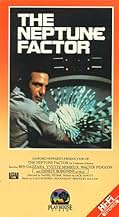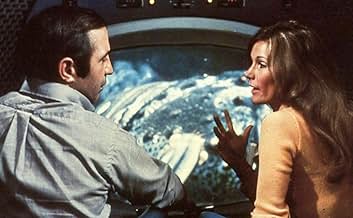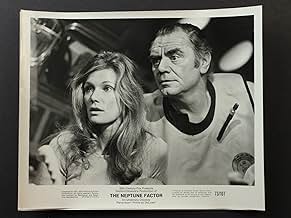AVALIAÇÃO DA IMDb
4,4/10
1,4 mil
SUA AVALIAÇÃO
Adicionar um enredo no seu idiomaWhen an underwater ocean lab is lost in a earthquake, an advanced submarine is sent down to find it and encounters terrible danger.When an underwater ocean lab is lost in a earthquake, an advanced submarine is sent down to find it and encounters terrible danger.When an underwater ocean lab is lost in a earthquake, an advanced submarine is sent down to find it and encounters terrible danger.
- Prêmios
- 1 indicação no total
Ken Pogue
- Diver Thomas
- (as Kenneth Pogue)
Avaliações em destaque
This waterlogged bore is about 100 minutes but feels about 120 minutes too long. A film so dull even the cast can't rouse itself from lethargy. Yvette Mimieux evidently decided her paycheck was only enough to guarantee that she'd show up, because her performance consists of only one half-lost/blank stare throughout. Borgnine, once again in the water (McHale, Poseidon, etc.) can barely rouse himself to his usual level of histrionics. Gazzara tries a southern accent and fails, while Walter Pigeon plods through his role, obviously taking his check to pad his retirement fund (he actually turned in a fine performance the following year in 'Harry in Your Pocket'). This is a Canadian film, thus it's restricted budget-wise, but why bother making a film like this if you haven't got the money for the special effects? We're talking $1.98 here. It looks like the producers bought a little toy submersible and borrowed someone's aquarium and let er rip. Okay, this is pre-Star Wars, effects-wise, but no one could take this seriously even back in 1973. Oh the look of fear and awe on Borgnine's face when he sees a.... giant goldfish! Perhaps the only thing of (minor) interest is whether James Cameron was inspired by this film to create 'The Abyss.' It does have some of the same elements. Of course, unlike 'The Abyss', this film is idiotic (example: Gazzara yelling at Mimieux for putting the sub in danger of exploding from sea pressure, yet the same pressure has no effect on HUMAN BODIES swimming around in EVEN GREATER DEPTHS soon after), and it's dully plotted, acted, directed, written, scored. Well, it IS consistent!
The Neptune Factor deals with some scientists who live and work out of an undersea lab in the Atlantic Ocean. One fine day while their bosses, Walter Pidgeon, Yvette Mimieux, and Ernest Borgnine are up top, an earthquake occurs and the lab topples over into an underwater crevice.
Though an atomic power submarine could stay down there indefinitely the problem is that crevice is way too small for one of those big boys. A smaller type submarine able to withstand the pressures of the very deep is needed and that's where Ben Gazzara and his ship the Neptune come in.
As disaster films go The Neptune Factor is small potatoes special effects wise. It's a Canadian production and I've seen Hollywood come up with worse films spending a ton more money than was done here.
The special effects such as they are, are merely movie films of some ordinary species of marine life blown up several times their size, because these are the creatures the crew finds down at depths that man hasn't been before. It's beautiful undersea photography just like a trip to Marineland.
It's a no frills production, no subplots of any kind, no social interaction of any kind with the crew, just do the mission and go home. That's why it was given a G rating when first released.
If you love Jacques Cousteau, you'll love this film.
Though an atomic power submarine could stay down there indefinitely the problem is that crevice is way too small for one of those big boys. A smaller type submarine able to withstand the pressures of the very deep is needed and that's where Ben Gazzara and his ship the Neptune come in.
As disaster films go The Neptune Factor is small potatoes special effects wise. It's a Canadian production and I've seen Hollywood come up with worse films spending a ton more money than was done here.
The special effects such as they are, are merely movie films of some ordinary species of marine life blown up several times their size, because these are the creatures the crew finds down at depths that man hasn't been before. It's beautiful undersea photography just like a trip to Marineland.
It's a no frills production, no subplots of any kind, no social interaction of any kind with the crew, just do the mission and go home. That's why it was given a G rating when first released.
If you love Jacques Cousteau, you'll love this film.
For a movie about a race against the clock to rescue a group of scientists trapped in an undersea research facility that's been hit by an earthquake, The Neptune Factor is incredibly dull. The problem is that for most of the movie, nothing happens. Ernest Borgnine (who I'll give a little credit as he does his best with this snoozer of a script), Ben Gazzara, and company spend most of the movie on a slow motion tour of the ocean floor looking for their missing colleagues. Garzzara is the worst, showing the same kind of emotion usually reserved for everyday, mundane tasks like doing the laundry or grocery shopping. You'd hardly know from his demeanor that the lives of three people rest in his hands. And when something does finally happen the special effects are so ridiculous looking that the movie losses any credibility it might have had. The "giant" sea creatures the rescuers run into are little more than normal salt water aquarium fish filmed with a zoom lens and a bad looking miniature of the submarine. That's right - The Neptune Factor looks like it was filmed in someone's home aquarium. A giant clown fish - oooooh, how scary! There's nothing much more frightening than the sight of a ludicrously large Nemo.
To say I was disappointed by The Neptune Factor would be a gross understatement. A good cast is put to waste with nothing to do. In the end, I've got to rate this one a 2/10.
To say I was disappointed by The Neptune Factor would be a gross understatement. A good cast is put to waste with nothing to do. In the end, I've got to rate this one a 2/10.
Not as exciting as the box cover artwork might suggest, with a painfully stilted characterisation by Ben Gazzara and capable supporting cast trapped in one-dimensional roles. The story concerns militant, officious salvage expert (Gazzara) contracted by an aquatic research team to recover a stricken underwater manned probe that has descended into a deep sea ravine. Gazzara makes it clear from the outset that his goal is only to locate the vessel for insurance purposes, except Mimieux's companion is one of those aboard and she ups the ante in spite of escalating challenges.
Pidgeon and Borgnine have little opportunity to establish any characterisation, while Mimieux simply frets and affects anxiety to demonstrate her 'depth' of character. The friction between her and Gazzara is about the only palpable action in the whole picture. The special effects consist of intense magnification of gold fish and other aquarium species, while endless jolts and turbulence puts you in the environmental context. As far as dialogue goes, the technical spec consists mainly of references to rudder malfunction and oxygen saturation. Riveting stuff.
Disappointingly, the film ends abruptly where it could have developed a more convincing, compelling climax. After waiting 95 minutes, the audience is treated to a Jules Verne moment in which 'giant' eels corral the probe's survivors as they run out of oxygen. But just as the action gains momentum, the film ends. Five more minutes of that encounter might have earned another star, but this underwater adventure is mostly talk and no action.
Pidgeon and Borgnine have little opportunity to establish any characterisation, while Mimieux simply frets and affects anxiety to demonstrate her 'depth' of character. The friction between her and Gazzara is about the only palpable action in the whole picture. The special effects consist of intense magnification of gold fish and other aquarium species, while endless jolts and turbulence puts you in the environmental context. As far as dialogue goes, the technical spec consists mainly of references to rudder malfunction and oxygen saturation. Riveting stuff.
Disappointingly, the film ends abruptly where it could have developed a more convincing, compelling climax. After waiting 95 minutes, the audience is treated to a Jules Verne moment in which 'giant' eels corral the probe's survivors as they run out of oxygen. But just as the action gains momentum, the film ends. Five more minutes of that encounter might have earned another star, but this underwater adventure is mostly talk and no action.
If I didn't know any better, I would say The Neptune Factor is a subtle parody on the "disaster Genre" movies of the 1970s. It is certainly not "Airplane", a zany take on the disaster genre, but rather an understated satire. The Rear screen projection of aquarium fish, only adds to the surreal, hypnotic affect this movie had on me. To quote Kirk Douglas from the Disney classic 20,000 Leagues Under the Sea, "Why I've seen scarier fish in my Aunt Fannie's gold fish bowl". Amazing what a little imagination and creativity can do for a parody of a low budget movie.
Você sabia?
- CuriosidadesProducer Sandy Howard consulted a large number of marine biologists, oceanographers, and ichthyologists two years prior to taking the script into production.
- Erros de gravaçãoNeptune's crew was able to watch through the submarine's glass window all the objects and fish around them under sunlight although they were deeper than 300 meters from the sea surface. Sunlight is barely seen in the sea bottom at depths greater than 200m.
- Citações
Dr. Leah Jansen: And those jawfish! The ones I've seen have been only two inches long. Look at them!
- ConexõesReferenced in O Moinho Negro (1974)
Principais escolhas
Faça login para avaliar e ver a lista de recomendações personalizadas
Detalhes
- Data de lançamento
- Países de origem
- Idioma
- Também conhecido como
- The Neptune Disaster
- Locações de filme
- Empresas de produção
- Consulte mais créditos da empresa na IMDbPro
Bilheteria
- Orçamento
- CA$ 2.500.000 (estimativa)
Contribua para esta página
Sugerir uma alteração ou adicionar conteúdo ausente
































